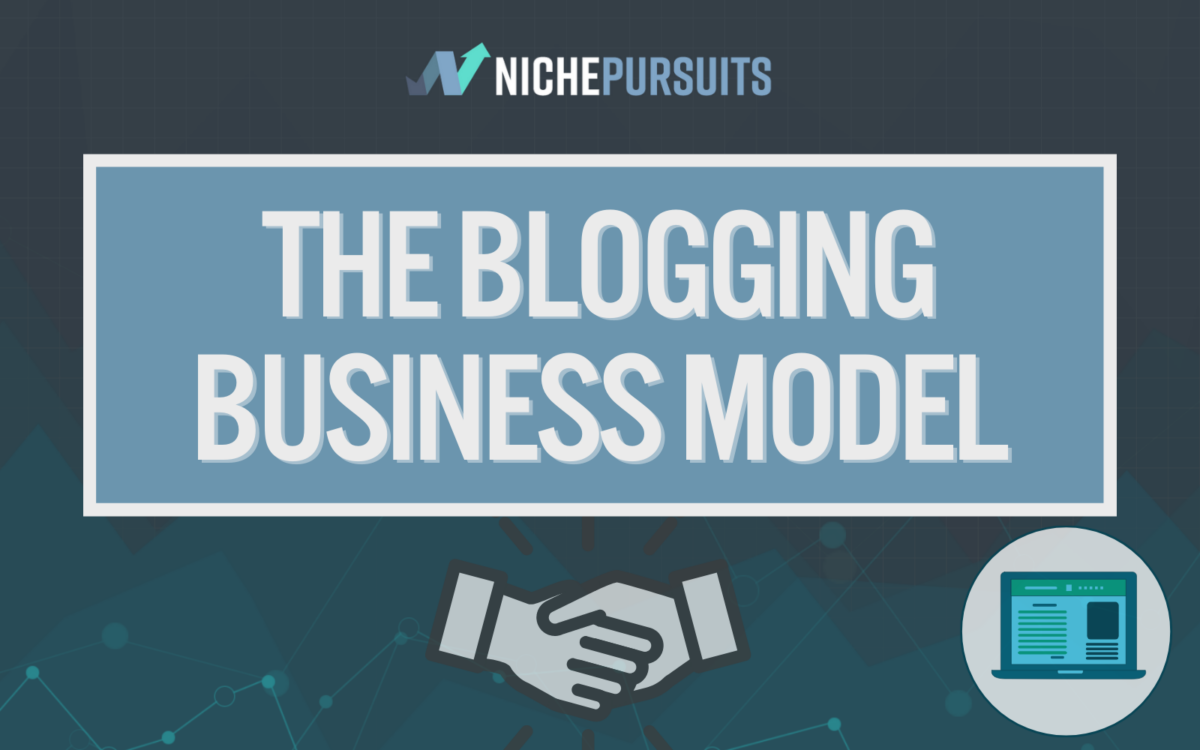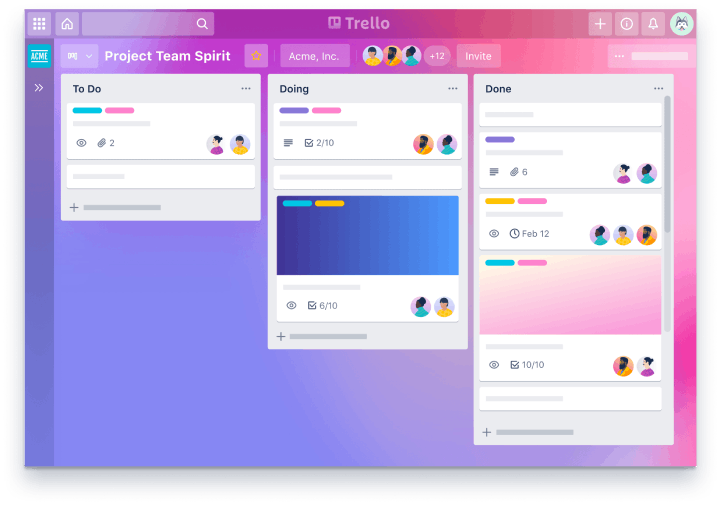The Blogging Business Model: What Is It and How Does It Work?

When you buy something through one of the links on our site, we may earn an affiliate commission.
Do you love blogging, but struggle to see it as a business? Whether you already have a blog or not, it is vital to understand the blogging business model so you can see the bigger picture.
Each part of the blogging process is an important piece of the puzzle, but unless you know the whole system, you will inevitably get lost.
This article will outline the key components of a business blog so you can achieve success sooner.
But first, let's answer an important question.
Contents
What are the Benefits of Starting a Blogging Business?
It's all very well to understand the concept of blogging, but what's more important is WHY it's a good business model to get into.
Here are several benefits of starting a blogging business.
It's perfect if you're an introvert

Have you wondered “should I start a blog?” Blogging is a great business for introverts because you can start your own business without being in the spotlight.
Some introverts dread the idea of creating energetic YouTube videos or speaking to prospects through sales calls.
With a blogging business, you can completely avoid these types of extroverted activities that many other business models require.
If you have an interest or skill in a certain area, you can transfer your knowledge in the form of written articles to build a connection with your audience.
No more cold calls, sales pitches, or answering to a demanding boss all day.
Your main role is to find out what your readers need help with and then write content on the subject. It's as simple as that.
And if you need help brainstorming topics, check out our list of what to blog about.
You are helping people solve problems
When your readers find your blog posts, you are indirectly helping them solve problems or things they want to get better at.
Any interaction you have with your audience can be done on your terms, whether it be through email, social media, or even in person. The choice is yours.
When you grow your audience with your blog and help many people, you become an authority on the subject you're interested in, but you can be as involved or removed as much as you want.
It's also a great felling to receive feedback from your readers who have gotten a lot of value from your writing.
You can also really define a level of expertise within your niche by analyzing your top-performing content and doubling down on what already works.
You can work from anywhere there's an internet connection

All you need to start, grow, and maintain a blogging business is a PC or laptop and an internet connection.
It's also a great business to start alongside your job.
You can work on your blog in the evenings and build up the income until it's making enough money to leave employment and become a full-time blogger.
Then, once you make enough income with your blogging business, you don't have to be tied to a desk all day. You can work from a coffee shop, a library, or beach if you really want.
It's highly scalable
Almost every part of the blogging process can be outsourced at scale.
This means that when your blogging business makes enough money, you can reinvest some of the revenue to freelancers and virtual assistants to write articles or manage the entire business.
When you're in the position of scaling a blogging business, you focus less on completing all the tasks in the business and take charge of moving the business in the right direction.
You're able to take a step back and establish how you can grow the blogging business faster.
It's future-proof
There will always be problems in the world. And as long as there are people with problems, there will be a market in solving them.
And this is what a blogging business does. It solves problems within a niche market.
It's also safe to say that the internet is here to stay and information is only getting more valuable.
As long as that stays true, blogging isn't going anywhere.
The Blogging Business Model: Starting at the End and Working Backwards
For clarity, here is each part of the blogging business model:
- Niche
- Avatar
- Traffic
- Content
- Monetization
- Exit
Let me explain each of these in reverse order, because it's important to start with the end in mind. You'll see why in a second.
Exit
Every business should have an exit strategy, including blogs.
It's likely your interests will change 10, 20, and 30 years from now. Or you might want to retire at some point and allow someone else to take the business to the next level.
Luckily, blogs are one of the easier businesses to sell because there are so many website brokers and website marketplaces.
Blogs and websites sell anywhere between 35-45 an income multiple of the monthly profit.
So, if your blog one day makes a regular monthly profit of $7,000, you'll have an asset worth between $245,000 and $315,000.
What a lot of entrepreneurs do in this industry is build multiple blogs and scale content production with a team of writers when they've got a good system in place.
It's a good idea to have an exit strategy in mind and set yourself an income goal so you have something to aim for.
Monetization

Blogging is only profitable when you monetize your traffic.
As a blog owner, you'll need to define which monetization strategy suits you best.
Most bloggers earn their living through advertising (these are the best ad networks for bloggers), affiliate programs, and subscription services, but your options are endless.
In the beginning, your blog will be small and won't get much traffic. The more content you add and the more relevant and valuable your content is, the quicker it will grow.
That's why it's not so important to add monetization in the very beginning. Sure, you can add some links to affiliate products, but focusing on content will benefit you in the long run.
If you want to build passive income, put in the effort with your content, then you can look at more monetization opportunities.
Here are a few ways to monetize a blog:
- Affiliate Marketing: Probably the most common and easiest way to monetize your site. All you need to do is sign up for an affiliate program such as Amazon and then add affiliate links to your content. Check out our Amazon Affiliate Program review if you're interested in this route.
- Display Ads: Another simple way to add blog income. New bloggers can use Google Ads or Ezoic's new service called Basic Ads. And those who generate 50,000 visits per month can use a service like Mediavine.
- Products or services: Some bloggers like the idea of creating their own physical product and using their blog traffic to market their products. This is a more advanced monetization strategy, but with potentially higher returns.
- Digital products or courses: If your blog teaches something, you can package up that knowledge and sell it in the form of a digital product, like an eBook or course.
- Memberships: An excellent opportunity for recurring revenue is to turn your blog into a membership site or develop a subscription model for gated content.
Throughout your blogging business, you'll want to keep revisiting ways to increase income.
Just one of these options could be enough to reach your income goals, but it's important to consider all your options before starting a new blog.
Content

Content is at the heart of a blogging business model. Without content, your blog won't offer value or generate traffic.
Good content also helps you build authority and become a trusted voice in your niche.
The best way to find success with your content marketing efforts is to develop a content strategy that complements your monetization model.
For example, if you focus on affiliate marketing in the beginning, then it's wise to add some product reviews and supporting articles to help those reviews rank higher.
If, however, you want to monetize with display ads, then content that teaches something could be better, because it keeps visitors on the page longer.
You also want to develop your content strategy around topics people are searching for in Google.
Try finding content clusters that fall under a broader topic where you can write between 20-40 articles on the subject.
This will build authority in your niche and topical relevance, both of which can drastically increase your SEO traffic.
Traffic
Blog traffic is another essential key to a successful blogging business. Like content, without traffic, your blog won't generate any revenue.
Luckily, because a blog relies on content, the most obvious traffic source will come from Google and Search Engine Optimization.
If you're writing the articles yourself, which is recommended in the beginning, you may as well invest some time in using keywords people are already searching for in Google.
You can accomplish this through keyword research.
Adding your chosen keyword in the title, URL slug, h2 tag, and in the intro and conclusion is sufficient enough in the beginning.
Update and Optimize
You can always go back into your top-performing articles in the future for further optimizations, like:
- Adding images with keywords in the alt text
- Expanding on the content to build more context
- Building topical relevance by adding supporting content for your top-performing posts
- Internal linking your articles to strengthen topical relevancy
If you are for some reason or another against Google traffic, then why not try other organic methods?
Options that might work for you include YouTube, Pinterest, Twitter, and Facebook.
Of course, to get enough traffic from these platforms, you'll need to be active on them every day so that your audience grows and naturally clicks through to your blog.
Avatar
A huge mistake people make when writing content for their blog is speaking to all people instead of a specific person within the niche.
They write to cater to everyone, instead of speaking directly to their audience.
The problem with this approach is that the reader doesn't feel like the content was written specifically for them. It goes over their head and they don't feel connected to the content.
A better approach is to define a specific person with specific goals and values and write your content directly for this person.
This is your customer avatar, or blog avatar, to be precise, and it is vital if you want to develop a better relationship with your audience.
When you speak to the core desires, values, and needs of your ideal reader, you build more trust, keep people reading longer, and generate more commissions.
So, how do you define your blog avatar?
Here are some key guidelines to follow:
- What is the primary goal of your niche market? This could be achieving optimal health and everyday vitality in the food and lifestyle niche.
- What are the core values of your ideal reader? For the above niche, core values could be health, longevity, aging well, focus, and productivity.
- What books do they read? Using the values above, books of interest could be The Bulletproof Diet by Dave Asprey and Why We Get Sick by Benjamin Bikman.
- Which blogs do they frequently read? These could be Tim Ferris, The Bulletproof Blog, or Mark's Daily Apple.
Finally, you'll want to make your avatar more real by giving them a name and defining some demographics.
To keep things simple, define things like their name, age, gender, home city/country, job, salary, and marital status.
This will help you feel more connected to your overall audience when writing articles for your blog.
To take it one step further, you could print off a stock portrait photo of what you think they might look like.
Niche
That leads us to the very first step when starting a blog: to find your blog niche.
Think of this as a customer segment trying to solve a problem or finding a product to help them improve their lives in some way.
Many people struggle to make decisions by themselves, so they turn to Google for answers.
Doing a quick search for “how to stop a rabbit from chewing” provides you with several blog posts that help rabbit owners protect items around the house.
A blog in the pet rabbit niche has endless opportunities for content to write about, problems to solve, and products to promote.
So, choose a niche based on a topic that doesn't limit your potential and provides you with a lot of opportunities for increasing revenue.
Niche areas to focus on include:
- Hobbies
- Personal finance
- Relationships
- Lifestyle
- Food
- Pets
- Technology
- Travel
- Fitness
Just make sure you don't start creating content within a niche that's too saturated, like losing weight or making money online.
Yes, it is still entirely possible to succeed in these competitive niches, but drill down into sub-topics that have a lot of long tail keywords.
For example, instead of targeting “how to lose weight”, you might have more success with “how to lose belly fat while on the Keto diet”.
Or instead of “how to make money online”, you could see more potential with “17 ways to make money on Fiverr”.
Choose your main niche from the ideas above, find some products on Amazon between $50-$150, drill down into a less competitive sub-niche, and start small.
You always have the choice to expand when your blog becomes an authority site.
The Blogging Process: Focus on Less, Achieve More
The process of blogging is quite different than the blogging business model.
The model encapsulates the blogging business as a whole. It's the big picture or vision you have for your blog, your “why”, and it helps you establish overall goals.
And the blogging process outlines important tasks that need to be carried out to achieve your blogging goals.
- Model = What is the blog about? How does it help people? What are the primary business goals?
- Process = What steps are involved to maintain growth? How will you achieve your primary goals?
The Blogging Process 101
Here is a quick summary of the process of growing a blog to continuously hit your blogging goals:
- Publish: This is the most important part of the blogging process. Without content, your blog has no value. If you create the content yourself, the process is simple; write every single day. If you outsource content, you'll need a system to hire a team; more on that in the next section.
- Measure: It's essential to track your blog's performance. Otherwise, you won't know where to make improvements or how effective your process is. You can track engagement metrics with Google Analytics and measure things like pageviews and content performance (learn more about the metrics tracked in Google Analytics).
- Optimization: Use the data you collect to refine the process. Find the topics that are performing the best and focus on creating more of the same to support what works. Each part of the system can be optimized, but so can the system as a whole.
The most important skill to learn with a blogging business is content creation and the ability to sit down every day and crank out articles.
If you have a budget to hire your own writers, that's great. However, for your first blog, you want to understand what makes a good blog post.
That's why it's a good idea to write the first 50-100 articles so you know how the system works. Once you know how each part of the process works, you'll find it so much easier to manage a team of writers.
Once you've reached your blogging goals and plan your exit, you can use the sale of the blog to fund other blogging projects or an entirely different business model if you choose.
Hire a Team of Writers
Once you've written a good chunk of articles for your blog and understand what it takes to write quality content, you will want to start outsourcing some or all of your content.
Getting to this stage in the blogging business is where you can really scale up growth. You go from working in the business to owning the business.
This is where you'll gain more freedom and start focusing your attention on ways you can double down on your blog strengths and areas of improvement.
You'll get to put more time into your marketing efforts and making sure your writers are creating consistently high-quality content.
All you need to do is sign up for an online writing site or job board, find some writers, and provide them with some details and requirements of the content you want.
These are known as content briefs and clarify your niche market, avatar, and articles you want with their targeted keywords.
Let's take a look at a few options when searching for writers.
3 Places to find good writers
- iWriter: A great platform to buy articles as and when you need them. iWriter is best for finding cheaper content quickly and less about building a team as everything is managed within your account.
- Upwork: A more advanced platform to find professional writers, build a team, and keep everything managed on the Upwork site and built-in messaging system.
- ProBlogger: One of the oldest and most widely used jobs board to find high quality freelance writers that you hire and manage directly in your business.
Our top recommendation for this process is Upwork.
Check Out UpworkBlogging Business Tools
Now that you have a better understanding of the blogging business model, let's that take a look at some tools to make the whole process a lot smoother.
WordPress plugins
WordPress plugins have endless potential for enhancing the functionality of your blog and overall features of your website.
But they can also make blogging tasks easier and a more enjoyable process.
Plugins like LinkWhisper will save you a bunch of time creating internal links between your articles and help you rank for more keywords.
Look Into LinkWhisperYou could use a plugin like Editorial Calendar to help you schedule content and stay consistent with publishing articles.
Plugins can be useful, but don't let them take up too much of your focus and distract you from the real markers of your blog's growth.
Productivity and staying organized

As you can tell from this guide, there are a ton of parts that make up a successful blogging business.
That's why it's vital to keep things organized so you can keep on top of content production, marketing practices, and managing your team of writers.
To ramp up productivity and keep your sanity, tools like Trello, Asana (see Asana vs Monday), and even a spreadsheet can be a lifesaver.
For example, Trello uses a kanban style workflow where you add cards to a list within a board.
Cards can be used to store details about the articles you're planning to write, which are stored in lists that manage the stages of completion.
These are managed within a board, which can organize different parts of the business model. For example, you can manage articles with a content production board and manage business goals with a blog performance board.
Text editors
If you're spending a lot of time writing articles, you'll want to find a text editor that you enjoy using.
Some people like to write directly into the WordPress editor, but this can sometimes feel a bit clunky or, in worst case scenarios, potentially make you lose your work if your website goes down mid-editing.
Editors like Google Docs will autosave your work and markdown editors like Obsidian won't carry over weird formatting when pasting into WordPress, and if you're also in need make sure to check out how to save an image from Google Docs.
Choosing the best text editor for blogging will depend on your own preferences and it may take testing a few to find which one works for you.
Copywriting software
The launch of AI writing tools and copywriting software have blown up in recent months and years and they are only getting better as they age.
As copywriting is an essential skill for creating high-converting content, tools that can help guide you in this process can be a worthy business investment.
ClosersCopy is a copywriting tool that helps you structure content in a way that motivates the reader to take action, whether that be joining your email list, staying on your site for longer, or making a purchase.
Other popular tools like Jasper.ai are getting better at writing entire articles and even books.
With the help of a human touch and strategic planning, these tools can help speed up your content creation process or, at the very least, banish writers block.
Blog content calendar
Compiling a spreadsheet of content ideas is one thing, but keeping up with content production is an entirely different ball game.
To stay consistent, consider creating a blog content calendar.
This can maximize your productivity by assigning specific articles to be published by a certain date, setting deadlines, or setting goals for how many article you want to publish each month.
To manage this process, you can use something as simple as a spreadsheet or Google calendar, or as advanced as a content calendar tool like CoSchedule.
CoSchedule lets you create a content calendar and keep everything organized in one place. They also have a free WordPress plugin to save you from having to login to multiple locations.
Conclusion
The blogging business model helps you treat your blog as a business, maintain goals, and earn more revenue.
A lot of blogging gurus overlook the big picture when they talk about blogging and make you think that there's a quick and easy path to passive income.
But shifting your mindset and taking your blog seriously can actually help you stick to achieving your goals and reaching success faster.
Want to learn step-by-step how I built my Niche Site Empire up to a full-time income?
Yes! I Love to Learn
Learn How I Built My Niche Site Empire to a Full-time Income
- How to Pick the Right Keywords at the START, and avoid the losers
- How to Scale and Outsource 90% of the Work, Allowing Your Empire to GROW Without You
- How to Build a Site That Gets REAL TRAFFIC FROM GOOGLE (every. single. day.)
- Subscribe to the Niche Pursuits Newsletter delivered with value 3X per week
My top recommendations
















